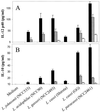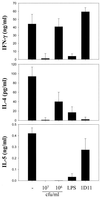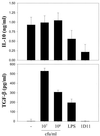Induction by a lactic acid bacterium of a population of CD4(+) T cells with low proliferative capacity that produce transforming growth factor beta and interleukin-10
- PMID: 11427413
- PMCID: PMC96129
- DOI: 10.1128/CDLI.8.4.695-701.2001
Induction by a lactic acid bacterium of a population of CD4(+) T cells with low proliferative capacity that produce transforming growth factor beta and interleukin-10
Abstract
We investigated whether certain strains of lactic acid bacteria (LAB) could antagonize specific T-helper functions in vitro and thus have the potential to prevent inflammatory intestinal immunopathologies. All strains tested induced various levels of both interleukin-12 (IL-12) and IL-10 in murine splenocytes. In particular, Lactobacillus paracasei (strain NCC2461) induced the highest levels of these cytokines. Since IL-12 and IL-10 have the potential to induce and suppress Th1 functions, respectively, we addressed the impact of this bacterium on the outcome of CD4(+) T-cell differentiation. For this purpose, bacteria were added to mixed lymphocyte cultures where CD4(+) T-cells from naive BALB/c mice were stimulated weekly in the presence of irradiated allogeneic splenocytes. In these cultures, L. paracasei NCC2461 strongly inhibited the proliferative activity of CD4(+) T cells in a dose-dependent fashion. This was accompanied by a marked decrease of both Th1 and Th2 effector cytokines, including gamma interferon, IL-4, and IL-5. In contrast, IL-10 was maintained and transforming growth factor beta (TGF-beta) was markedly induced in a dose-dependent manner. The bacteria were not cytotoxic, because cell viability was not affected after two rounds of stimulation. Thus, unidentified bacterial components from L. paracasei NCC2461 induced the development of a population of CD4(+) T cells with low proliferative capacity that produced TGF-beta and IL-10, reminiscent of previously described subsets of regulatory cells implicated in oral tolerance and gut homeostasis.
Figures




References
-
- Chen Y, Kuchroo V K, Inobe J, Hafler D A, Weiner H L. Regulatory T cell clones induced by oral tolerance: suppression of autoimmune encephalomyelitis. Science. 1994;265:1237–1240. - PubMed
MeSH terms
Substances
LinkOut - more resources
Full Text Sources
Other Literature Sources
Research Materials
Miscellaneous

